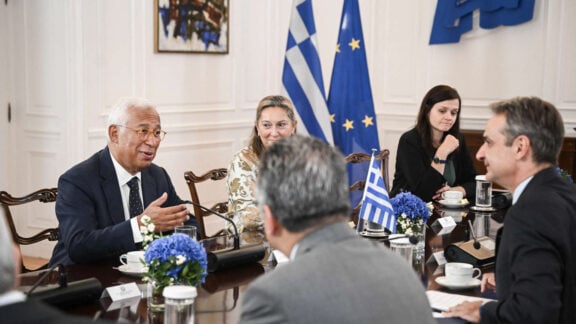As the creative producer of Namatjira by Big hART, the art and social justice theatre company, Sophia Marinos’ function is not merely to facilitate the creative process of the company, but to place the show in a greater social context. The work is political, but to achieve its maximum potential as a vehicle for change, it requires someone to actively connect it with organisations that are sympathetic, and to place it where it has the most resonance.
Marinos joined Big hART four years ago, and although she originally studied sociology, she was inspired by the power of art as a way to tap into society and communicate messages of social justice. And with the theatrical tradition in her family – her father is actor/director Lex Marinos and her mother actress Anne Grigg – it’s hardy surprising she should end up here.
Big hART Inc was founded 20 years ago in Tasmania in response to the closure of the Burnie pulp mill, which resulted in mass layoffs and endemic regional unemployment. The company’s objective was to relate with those who felt helpless and isolated by their situation, and help them to create new pathways through education and community involvement.
Since then, Big hART has extended its reach across most of Australia, engaging with the disadvantaged, and raising issues of equity and inclusion. Its aim is to find little-known stories and raise them up into mainstream consciousness, heightening community awareness, and hopefully catalysing change for the better.
Namatjira is an excellent case in point. Even 50 years after his death, Albert Namatjira is a fascinating subject in Australia. His paintings are wonderful, but he was much more than a great artist: he was a touchstone, a barometer of the times, and the embodiment of so many contradictions about the relationship between Aboriginal people and the governments of the day. It’s a complex story of a man caught between two worlds, encompassing issues of copyright, the rights of Indigenous people, and even of international human rights. Moreover, these are issues that are still relevant to Indigenous Australians today.
Marinos explains that the play had its genesis in an earlier Big hART piece, Ngapartji Ngapartji in which one of Albert’s grandsons, Elton Wirri, was performing. This connection seemed to generate a great deal of interest wherever the show went, and eventually became incontrovertible. From there, Big hART engaged with a number of Namatjira’s grandchildren, many of whom were watercolourists themselves, and a play about the painter’s life grew out of the earlier work.
Written and directed by Scott Rankin, and with Trevor Jamieson in the title role, a number of Albert’s grandchildren are also involved in the project.
You sense Marinos is passionate about her work. Employment such as this is much more than just a job. The position requires empathy, compassion and understanding. Her descriptions of her father’s upbringing as a first generation Greek Australian in Wagga Wagga, where there was a constant sense of being an outsider, when the differences between cultures were more pronounced and ‘otherness’ was inescapable, indicate that such lessons have not been wasted. These lessons will hold her in good stead for cultural projects aimed at inclusion, diversity and justice, exactly the type of thing Big ART are trying to do. In the meantime, Namatjira will tour until 2012, and will continue to utilise her talents.
The national tour of ‘Namatjira’ continues with shows in Victoria, NSW and the ACT where it will be performed in conjunction with a panel discussion at Parliament House. For event info, visit www.namatjira.bighart.org









